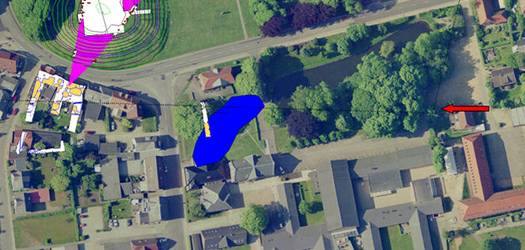- Steering group and management
- Sub-projects
- Jelling in GIS (Geographic Information System)
- Geophysical survey at Jelling
- Fieldwork 2011
- Archaeological fieldwork 2010
- Archaeological fieldwork 2009
- Jelling’s large stones
- The landscape around Jelling
- Place names in Jelling and its vicinity
- The bridge over Ravning Enge
- The travertine churches of East Jutland.
- Rune stones in context 2011
- Power and coins 2009
- Exhibitions
- Digitizing the photographs
Smededammen II
In 2007 Vejle Museum uncovered traces of a sturdy fence at Gormsgade 7-9 in Jelling. With the new knowledge produced by the excavations north of the North Mound, this was later interpreted as part of the southern fence line in a large square palisade around the monument area. In the autumn of 2009 this investigation was followed up with a new excavation, a south-north orientated trial trench, south of ”the Rector’s House” (Vejlevej 2). Its objective was to confirm the supposed fence line further to the east. However, the foundation ditch of the fence was not found here as expected. This indicates that in the south-eastern part of the large construction the fence line has a different course to what was expected and it is perhaps not as regular as in the north-east. Nor did the 2009 investigation establish the relationship between Smededammen and the palisade structure. Is Smededammen of a later date like the now filled in Seminariedam to the west, which was constructed in the 1800s, or was the pond in existence as early as the Viking period?
In 2010 the investigation turned to the area east of Smededammen. The aim here is to search for further evidence of the fence’s layout and, if possible, to locate the large structure’s south-eastern corner. Uncovering the corners is decisive to the understanding of the palisade structure’s form and character. The corner will also give a precise length for the eastern side.
The excavation is planned for June-July. A number of 2 m wide east-west orientated trial trenches will be dug in the car park east of Smededammen. If traces of the foundation ditch are located, these will be followed to the south, for as far as possible until the structure’s south-eastern corner is found. In specific locations the foundation ditch will be sectioned transversely and soil samples taken to provide charcoal for C14 dating.
Project coordinator: Museum Inspector Steen Wulff Andersen, Vejle Museum.


